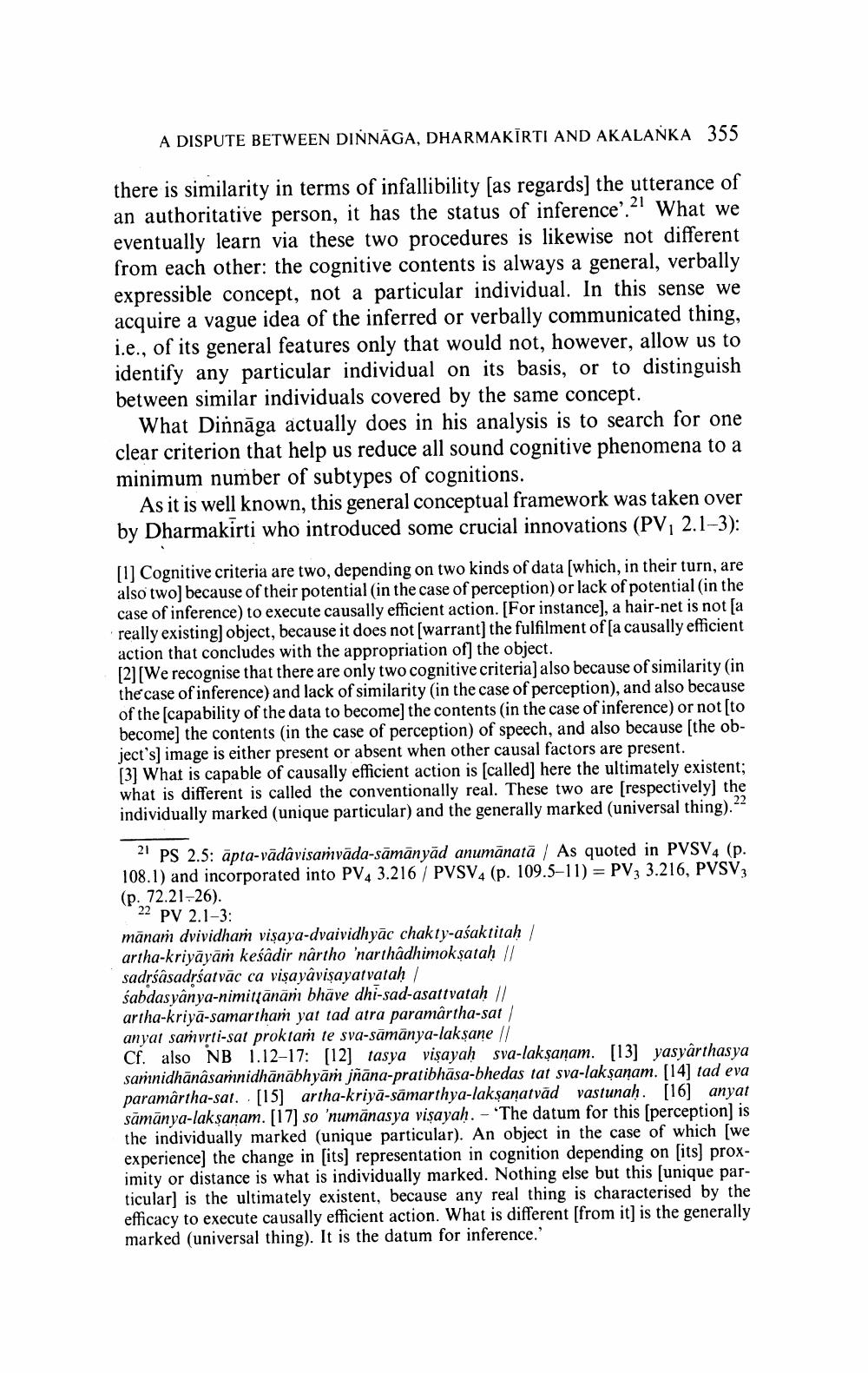________________
A DISPUTE BETWEEN DINNĀGA, DHARMAKĪRTI AND AKALANKA 355
there is similarity in terms of infallibility (as regards) the utterance of an authoritative person, it has the status of inference. What we eventually learn via these two procedures is likewise not different from each other: the cognitive contents is always a general, verbally expressible concept, not a particular individual. In this sense we acquire a vague idea of the inferred or verbally communicated thing, .e., of its general features only that would not, however, allow us to identify any particular individual on its basis, or to distinguish between similar individuals covered by the same concept.
What Dinnāga actually does in his analysis is to search for one clear criterion that help us reduce all sound cognitive phenomena to a minimum number of subtypes of cognitions.
As it is well known, this general conceptual framework was taken over by Dharmakirti who introduced some crucial innovations (PV, 2.1-3):
[U] Cognitive criteria are two, depending on two kinds of data (which, in their turn, are also two] because of their potential in the case of perception) or lack of potential (in the case of inference) to execute causally efficient action. [For instance), a hair-net is not a really existing) object, because it does not (warrant) the fulfilment of [a causally efficient action that concludes with the appropriation of] the object. [2][We recognise that there are only two cognitive criteria) also because of similarity (in the case of inference) and lack of similarity (in the case of perception), and also because of the capability of the data to become the contents in the case of inference) or not (to become) the contents (in the case of perception) of speech, and also because (the object's) image is either present or absent when other causal factors are present. [3] What is capable of causally efficient action is (called] here the ultimately existent; what is different is called the conventionally real. These two are (respectively) the individually marked (unique particular) and the generally marked (universal thing).22
21 PS 2.5: āpta-vādāvisamvāda-sāmānyād anumānatā / As quoted in PVSV4 (p. 108.1) and incorporated into PV4 3.216 / PVSV4 (p. 109.5-11) = PV3 3.216, PVSV3 (p. 72.21-26).
22 PV 2.1-3: mānam dvividham visaya-dvaividhyāc chakty-aśaktitah / artha-kriyāyām keśâdir nartho 'narthâdhimokşatah // sadrśâsadrśatvāc ca visayâvişayatvatah / śabdasyanya-nimittanam bhāve dhi-sad-asattvatah // artha-kriyā-samartham yat tad atra paramartha-sat / anyat saṁvrti-sat proktam te sva-sāmänya-lakşane // Cf. also NB 1.12–17: [12] tasya vişayah sva-laksanam. [13] yasyârthasya samnidhānâsamnidhānābhyām jñāna-pratibhāsa-bhedas tat sva-laksanam. [14] tad eva paramârtha-sat. [15] artha-kriya-samarthya-laksanatvād vastunah. [16] anyat sāmānya-laksanam. [17] so 'numānasya vişayah. - 'The datum for this (perception) is the individually marked (unique particular). An object in the case of which (we experience] the change in (its) representation in cognition depending on [its) proximity or distance is what is individually marked. Nothing else but this (unique particular) is the ultimately existent, because any real thing is characterised by the efficacy to execute causally efficient action. What is different [from it] is the generally marked (universal thing). It is the datum for inference.'
marthya-lak. The datum the case of Wis) prox




